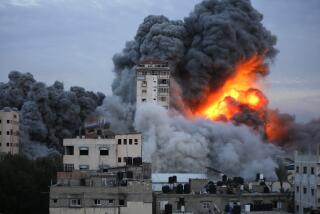Radiation Explored as Way to Spot Bombs From a Distance, Save Lives
- Share via
MANHATTAN, Kan. — Not a day seems to pass without U.S. troops being killed or wounded in Iraq, often from car or roadside bombs.
Halfway around the world, a Kansas State University nuclear engineering professor works on ways to detect improvised explosive devices -- IEDs in military parlance -- at a safe distance using neutron and gamma ray radiation.
William L. Dunn isn’t just seeking scholarly satisfaction.
“Everybody knows somebody affected by this war. Every single day somebody is being killed over there,” said Dunn, whose expertise is radiation measurement and applications. “There’s an urgency about this project because it could potentially save lives.”
About 1,950 members of the U.S. military have died since the beginning of the Iraq war in March 2003, and more than 14,000 have been wounded, according to an Associated Press count. Army Lt. Col. Barry Venable, a Department of Defense spokesman, said IEDs accounted for about 70% of attacks and more than a third of U.S. casualties.
Dunn thinks that technology routinely used to measure soil density or muscle fat in meat can be modified to detect explosives.
Dunn envisions two types of sensors. One would be large and transported in a van, perhaps for use at a vehicle checkpoint. Data from the sensor could be relayed to a computer a safe distance away.
Right now, the sensors must be within a couple of yards of an explosive, but Dunn’s goal is to extend their range to at least 30 feet, with detection in less than 10 seconds.
After the London transit bombings in July, Dunn started work on a smaller version -- about 3 feet by 2 feet -- that could be wheeled around to check suitcases, knapsacks and such.
“Working with existing technology, we’re not optimistic about making something hand-portable, but as technology advances, that may be possible,” he said.
Dunn also wants to determine the minimum size of an explosive and how to identify it through other material.
“Obviously, if we deploy something that detects explosives, the enemy will simply try to obscure them more and more,” Dunn said. “We want to be able to detect the explosives within a lot of clutter.”
The timetable from research to reality depends on funding, Dunn said. He has a $200,000 grant from the Marine Corps, but “if we get more money, we could develop a small detector in a year and a larger one in less than two years. At the current rate, it would take four years,” Dunn said.
John Blair, program manager for M2 Technologies Inc., a conduit between researchers and the military, brought the idea to Dunn.
Blair said research elsewhere on IED detection took different approaches.
“They’re looking at everything from better sniffers to better X-ray machines,” Blair said. “What is unique about [Dunn’s] research is the methods used to analyze the data.”
He said Dunn’s research showed promise.
“We gave him a little bit of seed money to see if it can work and he did it,” Blair said. “Because of recent events in London, we have looked at accelerating this.”
Blair said the eventual goal was to identify a bomb 200 yards away and detect roadside IEDs while moving quickly.
“Are we there? No. Are we close? No. Are we on the path that could be successful? And the answer is yes,” Blair said.
Back at Dunn’s laboratory, which looks like a storage yard, 10-gallon plastic barrels of, variously, fertilizer, sand and water sit near a 3-square-foot aluminum box atop a platform. Cables and electrical cords snake around the floor. Three metal canister-shaped detectors relay information to a laptop computer.
A barrel of fertilizer is placed in the box. (Fertilizer substitutes for explosives because it has some of the same properties, such as a high nitrogen content that reacts much the same way to the radiation.) Then neutrons and gamma ray radiation are beamed in.
The detectors read the return signals, which go into the computer to determine whether there’s something to worry about.
“We’re trying to get as many signatures as possible to see if it’s likely that an explosive is present,” Dunn said. “Any one by itself wouldn’t be conclusive, but in combination, we’re trying to show it’s likely to be an explosive material.”
Using radiation to identify concentrations of several elements in explosives seems promising, said a nuclear physicist not involved in Dunn’s research.
“Instead of looking for one aspect of the data, you look at multiple aspects at the same time,” said Cornelius Beausang of the University of Richmond in Virginia. “Certainly, it is a legitimate way to detect explosives.”
He cautioned: “Whether you can make it work for a roadside bomb in Baghdad is a challenge.
“But it’s not impossible, I think.”
The technology may be complex, but Dunn has a simple goal.
“We’re looking for one thing. We’re only interested if there are explosives on board,” he said.
More to Read
Sign up for Essential California
The most important California stories and recommendations in your inbox every morning.
You may occasionally receive promotional content from the Los Angeles Times.













